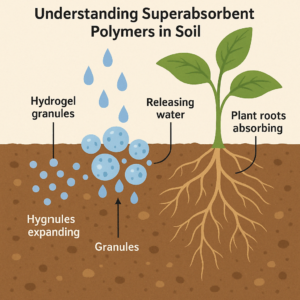Superabsorbent polymers (SAPs), also known as hydrogel granules or water-storing crystals, are cross-linked polyacrylamide or potassium polyacrylate materials that can absorb and retain water hundreds of times their dry weight. Once hydrated, these granules swell into a gel-like substance, gradually releasing water back to plant roots as soil dries. Incorporating SAPs into your planting mix or garden soil can significantly improve moisture retention, reduce irrigation frequency, and promote more uniform plant growth.

How to Incorporate Hydrogel Granules
-
Pre-hydration Method
-
Ratio: Mix 1 gram of dry granules per liter of water (≈1:1000 by weight).
-
Procedure: Sprinkle the granules into a bucket of water, stir gently until fully expanded (about 15–30 minutes).
-
Sovellus: Pour the swollen gel into planting holes or pots, then add soil on top. This ensures even distribution around the root zone.
-
-
In-Soil Mixing
-
Ratio: Blend approximately 0.1–0.2% by volume of dry granules into potting soil or backfill (about 100–200 mL of granules per 100 L of soil).
-
Procedure: Spread the granules over the surface of soil, mix thoroughly to a depth of 4–6 inches (10–15 cm).
-
Sovellus: Plant seeds, transplants, or established plants as usual. The granules swell after the first irrigation and remain effective for several seasons.
-
-
Lawn Topdressing
-
Ratio: Broadcast about 50–100 g of dry granules per square meter.
-
Procedure: Apply evenly over the lawn surface, then rake lightly to incorporate into the top 1–2 cm of soil.
-
Sovellus: Follow with a normal watering cycle to activate the granules.
-
Usage Tips and Best Practices
-
Planting Mixes: Ideal for container gardens, hanging baskets, and seed-starting mixes. The fine 20–100 mesh granules blend seamlessly without altering soil texture.
-
Vegetable and Herb Gardens: SAPs are food-safe and can be used directly in raised beds. They aid in moisture retention during hot spells, reducing plant stress and improving yields.
-
Tree and Shrub Establishment: For newly planted trees, placing a hydrated gel ring around the root ball can boost survival rates, especially in sandy soils.
-
Soil Longevity: Once activated, these hydrogels remain effective for up to seven years, breaking down slowly without leaving harmful residues.
-
Irrigation Efficiency: Expect up to a 50% reduction in watering frequency. In arid climates or during droughts, this can translate to substantial water savings.
Real-World Customer Cases
Case Study 1: Urban Rooftop Vegetable Garden
Scenario: An apartment dweller in downtown Los Angeles struggled with daily watering and rapid soil drying under full sun.
Implementation: Pre-hydrated hydrogel was mixed into each container (approx. 2 L gel per 10 L pot).
Outcome:
-
Watering reduced from daily to twice weekly.
-
Tomato plants produced 30% more fruit over the season compared to the previous year.
-
No noticeable change in soil pH or nutrient availability.
Case Study 2: Commercial Lawn Care in Florida
Scenario: A hotel’s beachfront lawn required uniform green coverage despite sandy soil and saline irrigation.
Implementation: 80 g of dry granules per square meter incorporated via topdressing, followed by standard irrigation.
Outcome:
-
Turfgrass moisture levels remained consistent even during peak heat, eliminating brown patches.
-
Mowing height could be lowered by 0.5 cm without stressing the grass, improving aesthetics.
-
Irrigation cycles cut by 40%, saving 120,000 L of water over three months.
Case Study 3: Community Flower Bed Restoration
Scenario: A neighborhood association revitalized a neglected flower bed prone to drought stress.
Implementation: Granules mixed at 0.15% by volume into the planting soil; native wildflower seeds sown on top.
Outcome:
-
Germination rates improved from 60% to 85%.
-
Flowers bloomed earlier in the season and lasted two weeks longer.
-
Maintenance volunteers reported softer maintenance duties due to less frequent hand-watering.
Case Study 4: Indoor Orchid Culture
Scenario: An orchid enthusiast sought to maintain high humidity and consistent moisture without risking root rot.
Implementation: A thin layer of pre-swollen hydrogel placed beneath each plant’s topcoat of bark.
Outcome:
-
Watering intervals extended from once a week to once every ten days.
-
Flower spikes increased by an average of two per plant.
-
No incidents of overwatering or microbial issues.
Päätelmä
Superabsorbent hydrogel granules offer an effective, long-lasting solution for improving soil moisture dynamics across a wide array of horticultural applications—from container gardening and orchards to large-scale lawns and community beds. By following proper mixing ratios and application methods, you can reduce both watering frequency and fertilizer leaching, while supporting healthier, more resilient plants. Whether you’re a weekend gardener, commercial landscaper, or indoor plant aficionado, these polymer granules can help optimize water use and enhance plant performance for years to come.

